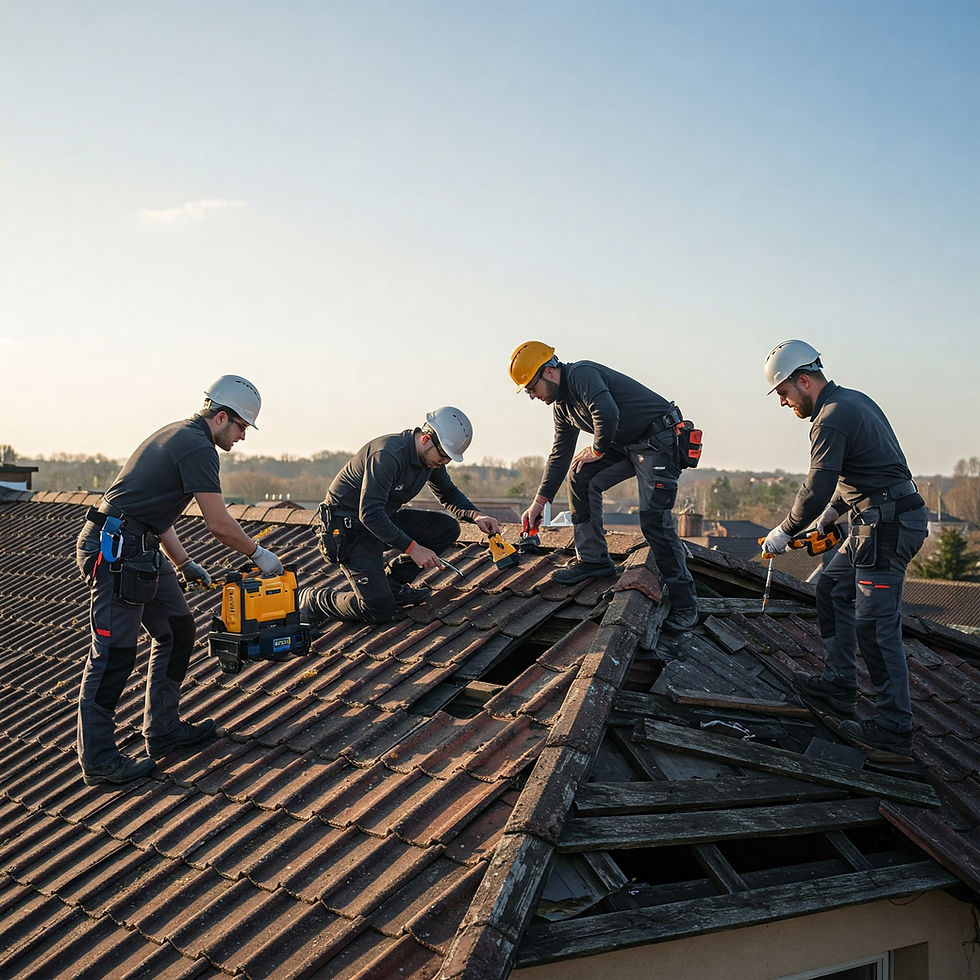The Impact of Roofing Materials on Repair Choices and Cost Implications for Homeowners
- Adam Smith
- May 27
- 3 min read
The roof is much more than just a cover. It protects your home and adds to its visual charm. Choosing the right roofing material is critical, as it has a significant effect on repair options and overall costs. Understanding how different roofing materials influence these factors is essential for homeowners looking to repair or replace their roofs.
Understanding Roofing Materials
Roofing materials come in various forms, including traditional choices like asphalt shingles and wood shakes, as well as modern picks such as metal, slate, and flat roofing systems. Each type has unique features that affect repair options, frequency of repairs, and costs.
For example, asphalt shingles are widely appreciated for their affordability, typically costing between $90 and $100 per square (100 square feet) installed. Their ease of installation makes repairs simpler and cheaper than with materials like slate. On the other hand, slate roofing, while offering a lifespan of over 100 years, can cost between $700 and $1,000 per square. This high cost often necessitates hiring skilled professionals, raising repair prices substantially.
The Role of Durability
How long a roofing material can last significantly affects how often repairs need to occur and how costly those repairs will be. Durable materials, such as metal, can last 40 to 70 years with little maintenance, potentially leading to fewer repairs. In contrast, asphalt shingles typically last between 15 to 30 years and may require more frequent replacements due to environmental wear.
Investing in a long-lasting roofing material can pay off. For instance, homeowners might find that switching to a metal roof might cost around $400 to $600 per square upfront. However, since it requires fewer repairs, it may save about 30% over the lifespan compared to asphalt shingles.

Repair Options for Common Roofing Types
Asphalt Shingles
Asphalt shingles are the most common roofing material due to their low cost and accessibility. Homeowners can easily patch or replace individual shingles without needing a full roof replacement, which helps keep expenses down.
However, if repairs are needed years after installation, colour and style matching can become challenging. Homeowners should consider keeping a few spare shingles, which can reduce future repair costs by eliminating the need to buy an entirely new bundle.
Flat Roofing Systems
Flat roofs can lead to unique repair challenges. Typically made from materials like EPDM rubber or TPO, these roofs can suffer from pooling water, which can lead to leaks.
Repairs often require specialised skills, making it essential to hire a qualified contractor. These repairs can be costly, averaging between $300 and $600, depending on the extent of the damage. Scheduling regular inspections can help identify minor issues early, potentially reducing repair costs by up to 50%.
Pitched Roofing
Pitched roofing, including tiles and shingles, combines aesthetics and functionality. However, the repair process can differ drastically based on the materials used.
For instance, repairing a tile roof may require replacing whole sections if several tiles are cracked, raising costs often to around $1,000 or more. Conversely, repairing a shingled roof might only involve replacing a few shingles at a much lower price point. Weather-related incidents, such as severe hail or storms, can also lead to widespread damage, dramatically increasing repair expenditures.
Factors Impacting Repair Costs
Several key factors influence the overall costs of roof repairs:
Material Type: Costs can vary widely based on material choices. High-quality materials often require more expensive skills for installation and repair.
Roof Design: Complex designs with multiple angles and features can exponentially increase labour costs compared to simpler, straightforward roofing layouts.
Location: Local climates can dictate material choice, affecting both initial costs and long-term repair expenses. For instance, homes in areas with heavy snow loads may require stronger materials, like metal, which can increase costs by 20% to 30%.
Labour Costs: The availability of skilled contractors varies by region and can significantly affect overall repair costs. Investing time in finding a reputable contractor can save homeowners from inflated labour charges.
Final Thoughts
Ultimately, the choice of roofing material impacts both repair options and costs for homeowners. From understanding the durability and maintenance ease to recognising the complexities of repair processes, each material has its unique strengths and challenges.
Homeowners are encouraged to consider their long-term needs and consult local roofers for the best materials within their budget. Thoughtful decision-making regarding roofing can enhance a home's defence, elevate its appearance, and lead to considerable savings on repairs in the future.
Regular inspections and prompt attention to minor damages are critical in preserving a roofing system's integrity, ensuring peace of mind and protection for one of life's most significant investments.



Comments